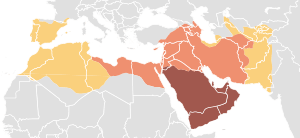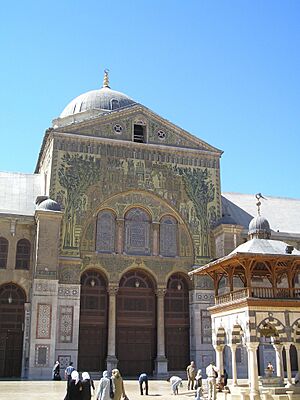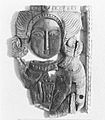Umayyad Caliphate facts for kids
Quick facts for kids
Umayyad Caliphate
ٱلْخِلَافَة ٱلْأُمَوِيَّة
|
|||||||||||||||||||||||||||||||
|---|---|---|---|---|---|---|---|---|---|---|---|---|---|---|---|---|---|---|---|---|---|---|---|---|---|---|---|---|---|---|---|
| 661–750 | |||||||||||||||||||||||||||||||
|
The Umayyad dynastic color was white.
|
|||||||||||||||||||||||||||||||

The Umayyad Caliphate at its greatest extent in AD 750
|
|||||||||||||||||||||||||||||||
| Capital | |||||||||||||||||||||||||||||||
| Capital-in-exile | Córdoba (756–1031) | ||||||||||||||||||||||||||||||
| Common languages | Classical Arabic (official) – Coptic, Greek, Latin, Persian (official in certain regions until the reign of Abd al-Malik) – Aramaic, Armenian, Kurdish, Berber languages, African Romance, Mozarabic, Sindhi, Georgian, Prakrit | ||||||||||||||||||||||||||||||
| Religion | Sunni Islam | ||||||||||||||||||||||||||||||
| Government | Caliphate | ||||||||||||||||||||||||||||||
| Caliph | |||||||||||||||||||||||||||||||
|
• 661–680
|
Muawiya I (first) | ||||||||||||||||||||||||||||||
|
• 744–750
|
Marwan II (last) | ||||||||||||||||||||||||||||||
| History | |||||||||||||||||||||||||||||||
|
• Muawiya I becomes caliph
|
estimated from 660 to 665 | ||||||||||||||||||||||||||||||
| 750 | |||||||||||||||||||||||||||||||
| Area | |||||||||||||||||||||||||||||||
| 720 | 11,100,000 km2 (4,300,000 sq mi) | ||||||||||||||||||||||||||||||
| Currency | |||||||||||||||||||||||||||||||
|
|||||||||||||||||||||||||||||||
The Umayyad Caliphate was the second big Islamic caliphate (empire) that formed after the death of Muhammad. It was one of the largest empires in the world at that time. In fact, it is the fifth largest empire in all of history!
This empire was ruled by the Umayyad Dynasty. This family, also known as Banu Umayyah, came from Mecca in what is now Saudi Arabia. The capital city of the Umayyad Caliphate changed over time. It was Damascus from 661 to 744, then Harran from 744 to 750. Later, when the Umayyads were no longer in power in the main caliphate, their capital in exile was Córdoba from 756 to 1031.
Contents
Who Were the Umayyads?
The Umayyad family and the Islamic Prophet Muhammad shared a common ancestor named Abd Manaf ibn Qusai. Muhammad's family came from Abd Manaf's son, Hashim. The Umayyads came from a different son, Abd-Shams.
So, these two families were like different branches of the same large Arabian tribe called the Quraish.
The Umayyads and Muhammad's family (the Hashimites) had a strong rivalry. This started because Abu Sufyan ibn Harb, a grandson of Umayya, was against Muhammad and the new religion of Islam at first. He even fought battles to try and stop Islam.
However, Abu Sufyan and his son, Muawiyah I, later accepted Islam. They became very important because they had great political and diplomatic skills. These skills were much needed to help manage the quickly growing Islamic empire.
How the Umayyad Caliphate Began
The Umayyad rule started after the assassination of Uthman in 656. After Uthman's death, Ali, who was a cousin of Prophet Muhammad, became the caliph.
Ali faced opposition from different groups. He moved his capital from Medina to Kufa. This led to a conflict that lasted from 656 to 661. This period is known as the First Fitna, which means "time of trial" or civil war.

One group that opposed Ali was led by Aisha, who was Muhammad's widow. Other leaders included Talhah and Al-Zubayr, who were companions of the Prophet. These groups fought Ali at the Battle of the Camel in 656. Ali won this battle.
When Ali was assassinated in 661, Muawiyah I marched to Kufa. He convinced many of Ali's supporters to accept him as caliph instead of Ali's son, Hasan.
After becoming caliph, Muawiyah moved the capital of the caliphate to Damascus. Syria remained the main base of Umayyad power until their dynasty ended.
Related Pages
Images for kids
-
The Dome of the Rock in Jerusalem.
-
The Caliphate at the beginning of the Abbasid revolt, before the Battle of the Zab.
-
Coin of the Umayyad Caliphate, based on a Byzantine prototype, 695.
-
Ivory (circa 8th century) discovered in the Abbasid homestead in Humeima, Jordan.
See also
 In Spanish: Califato omeya para niños
In Spanish: Califato omeya para niños














